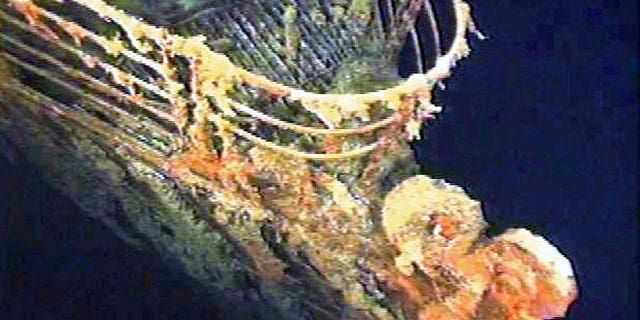A search was still underway Monday afternoon for a missing five-person submersible used to take tourists to see the underwater wreckage of the Titanic, but one expert says he remains “very hopeful” and “very positive.”
Speaking to Canada’s NTV Evening News, Titanic expert Larry Daley acknowledged the dangers of deep submersible diving, but argued that technology has gotten much better in recent years.
This 2004 photo provided by the Institute for Exploration, Center for Archaeological Oceanography/University of Rhode Island/NOAA Office of Ocean Exploration, shows the remains of a coat and boots in the mud on the sea bed near the Titanic’s stern. (Institute for Exploration, Center for Archaeological Oceanography/University of Rhode Island/NOAA Office of Ocean Exploration, File)
“Deep submersible diving is very dangerous, but it’s very hi-tech. And as each year goes by, the equipment gets better, the technology gets better,” Daley said. “So, I’m very hopeful. I’m very positive.”
Daley also noted that participants can stay in the vessel for hours if the equipment is maintained properly.
TITANIC SUBMARINE TOUR COMPANY OCEANGATE EXPEDITIONS: WHAT TO KNOW
The Joint Rescue Coordination Centre in Halifax, Nova Scotia, said the vessel was reported overdue around 9:13 p.m. Sunday, about 435 miles south of St. John’s, Newfoundland. Lt. Cmdr. Len Hickey said a Canadian Coast Guard vessel and military aircraft were assisting the search effort, which was being led by the U.S. Coast Guard in Boston.
OceanGate Expeditions confirmed the search for its submersible and said its focus was on those aboard the vessel and their families.

FILE PHOTO: The port bow railing of the Titanic lies in 12,600 feet of water about 400 miles east of Nova Scotia as photographed earlier this month as part of a joint scientific and recovery expedition sponsored by the Discovery Channel and RMS Titantic. (Reuters/File photo/File Photo)
“We are deeply thankful for the extensive assistance we have received from several government agencies and deep sea companies in our efforts to reestablish contact with the submersible,” the company said in a statement. “We are working toward the safe return of the crewmembers.”
David Concannon, an adviser to the company, said Oceangate lost contact with the sub Sunday morning. It had a 96-hour oxygen supply.
“Now 32 hours since sub left surface,” said Concannon, who said he was supposed to be on the dive but could not go due to another client matter. He said officials are working to get a remotely operated vehicle that can reach a depth of about 20,000 feet to the site as soon as possible.
NEVER-BEFORE-SEEN FOOTAGE OF THE TITANIC NEARLY 12,500 FEET BELOW THE OCEAN RELEASED

Search and rescue operation underway by US Coast Guard in Boston after a tourist submarine bound for the Titanic’s wreckage site went missing off the southeastern coast of Canada. (Yasin Demirci/Anadolu Agency via Getty Images)
Action Aviation confirmed that its company chairman, U.K. businessman Hamish Harding, was one of the tourists on board. The company’s managing director, Mark Butler, told the AP that the crew set out on Friday.
“Every attempt is being made for a rescue mission. There is still plenty of time to facilitate a rescue mission, there is equipment on board for survival in this event,” Butler said. “We’re all hoping and praying he comes back safe and sound.”
CLICK HERE TO GET THE FOX NEWS APP
The expedition was OceanGate’s third annual voyage to chronicle the deterioration of the iconic ocean liner that struck an iceberg and sank in 1912, killing all but about 700 of the roughly 2,200 passengers and crew. Since the wreckage’s discovery in 1985, it has been slowly succumbing to metal-eating bacteria, and some have predicted the ship could vanish in a matter of decades as holes yawn in the hull and sections disintegrate.
The Associated Press contributed to this report.